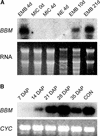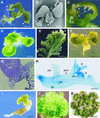Ectopic expression of BABY BOOM triggers a conversion from vegetative to embryonic growth
- PMID: 12172019
- PMCID: PMC151462
- DOI: 10.1105/tpc.001941
Ectopic expression of BABY BOOM triggers a conversion from vegetative to embryonic growth
Abstract
The molecular mechanisms underlying the initiation and maintenance of the embryonic pathway in plants are largely unknown. To obtain more insight into these processes, we used subtractive hybridization to identify genes that are upregulated during the in vitro induction of embryo development from immature pollen grains of Brassica napus (microspore embryogenesis). One of the genes identified, BABY BOOM (BBM), shows similarity to the AP2/ERF family of transcription factors and is expressed preferentially in developing embryos and seeds. Ectopic expression of BBM in Arabidopsis and Brassica led to the spontaneous formation of somatic embryos and cotyledon-like structures on seedlings. Ectopic BBM expression induced additional pleiotropic phenotypes, including neoplastic growth, hormone-free regeneration of explants, and alterations in leaf and flower morphology. The expression pattern of BBM in developing seeds combined with the BBM overexpression phenotype suggests a role for this gene in promoting cell proliferation and morphogenesis during embryogenesis.
Figures






References
-
- Aleith, F., and Richter, G. (1990). Gene expression during induction of somatic embryogenesis in carrot cell suspensions. Planta 183, 17–24. - PubMed
-
- Asker, S.E., and Jerling, L. (1992). Apomixis in Plants. (Boca Raton, FL: CRC Press).
-
- Binet, M.N., Lepetit, M., Weil, J.H., and Tessier, L.H. (1991). Analysis of a sunflower polyubiquitin promoter by transient expression. Plant Sci. 79, 87–94.
-
- Boutilier, K.A., Gines, M.J., DeMoor, J.M., Huang, B., Baszczynski, C.L., Iyer, V.N., and Miki, B.L. (1994). Expression of the BnmNAP subfamily of napin genes coincides with the induction of Brassica microspore embryogenesis. Plant Mol. Biol. 26, 1711–1723. - PubMed
Publication types
MeSH terms
Substances
Associated data
- Actions
- Actions
- Actions
- Actions
LinkOut - more resources
Full Text Sources
Other Literature Sources
Molecular Biology Databases
Research Materials

